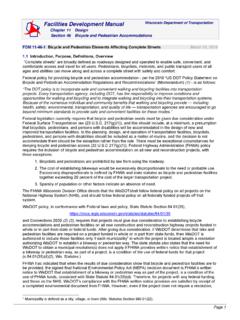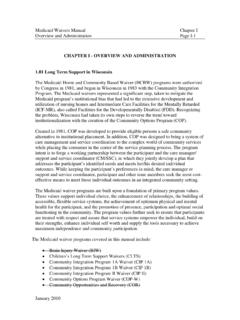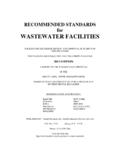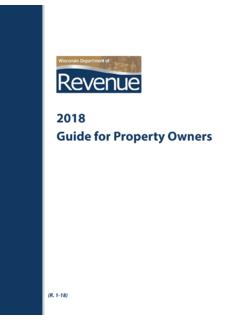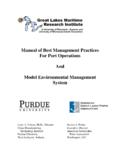Transcription of Calibration Guide for Ground-Speed-Controlled and …
1 Calibration Guide FOR Ground-Speed-Controlled AND manually controlled material SPREADERS February 2009 Prepared for Clear Roads Technical Advisory Committee Pooled Fund Project #TPF-5(092) Prepared by Blackburn and Associates 2 Calibration Guide PREFACE This Calibration Guide is based upon information contained in a Clear Roads research report entitled, Calibration Accuracy of Manual and Ground-Speed-Controlled Salters. Both the Guide and related research were funded by the Wisconsin Department of Transportation (WisDOT) and the United States Department of Transportation (USDOT) under the Clear Roads pooled fund #TPF-5(092) and WisDOT Project #0092-06-21. The Clear Roads pooled funded research program is an ongoing cooperative and comprehensive research activity that focuses on field testing and evaluation of materials, methods, and equipment used in highway winter maintenance.
2 The authors of this Guide were Robert R. Blackburn, the Principal Investigator and Overall Project Manager, Edward J. Fleege and Duane E. Amsler. 3 Table of Contents PREFACE ..2 Table of 1. 2. Background on Equipment Operations for Spreaders ..4 3. Background on Calibration ..6 4. Equipment, material , and Facilities Needed for Calibration and Calibration Verification Equipment, material , and Facilities Needed for Calibration .. 7 Calibration of Dry Solid material Spreaders .. 8 Calibration of Prewetting 12 Equipment, material , and Facilities Needed for Calibration Verification 13 Verification Testing of Dry Solid material Spreaders .. 13 Verification Testing of Prewetting Systems .. 13 5. Calibration in Closed-loop Mode of Operation.
3 14 Preparation for Calibration .. 14 Calibration Check List .. 16 Calibration According to Manufacturer s Specifications .. 17 Calibration Verification Acceptance of Calibration Tests .. 19 6. Calibration in Open-loop Mode of Operation ..21 Preparation for Calibration .. 21 Calibration Check List .. 23 Calibration According to Manufacturer s Specifications .. 24 7. Calibration of manually controlled Calibration According to Manufacturer s Specifications .. 26 Salt Institute Procedure .. 26 8. Recommended Timing and Frequency of 9. Calibration Record Keeping ..27 APPENDIX A - Calibration VERIFICATION TEST FORM ..29 APPENDIX B - SALT INSTITUTE PROCEDURES AND CHART USED TO CALIBRATE SOLID material SPREADERS WITH MANUAL CONTROLLERS.
4 31 41. Introduction The unprecedented high cost of diesel fuel and materials used for snow and ice control presents a severe demand on the budgets for winter maintenance operations. Now more than ever, it is imperative that snow and ice control operations need to be conducted in the most efficient and cost-effective manner possible. Research results based upon operational experiences provide the manager of snow and ice control operations with guidance on the appropriate chemical application rates for a wide range of weather, traffic, and site conditions (1-3). However, this guidance is of no value unless the material discharge rates from spreaders can be automatically and accurately controlled .
5 Automatic control of material application rates used in highway winter maintenance operations is achieved with ground-speed-oriented controllers. Currently, there are a wide variety of controllers manufactured. Most ground-speed controllers used in the automatically adjust hydraulic fluid flow in proportion to ground speed. A truck operator with an automatic controller is able to maintain a constant application rate of material on the road without having to adjust the valve opening to conform to the changing speed of the truck. To spread a constant amount of material along a road segment, a truck operator needs only to select an application rate. The installation of a controller in a spreader truck does not guarantee that the solid and liquid discharge goals will be automatically and accurately achieved.
6 The discharge goals depend not only on how will the controller functions, but also on how will the controller interfaces with the truck- spreader system. In order for spreader /controller combinations to optimally discharge solid and prewetting material , their Calibration settings need to accurate. A study entitled, Calibration Accuracy of Manual and Ground-Speed-Controlled Salters was conducted under the Clear Roads winter maintenance pooled funded project (4). The study documented the accuracy of automated systems in delivering snow and ice control materials in various combinations, with a focus on dry materials. An important aspect of the Calibration study was the development of procedures for the proper Calibration of spreader /controller combinations.
7 Those procedures form the bases for the Calibration Guide . Following this information, the Guide is divided into eight additional sections plus two appendixes. Section 2 describes the background on equipment operations for spreader . Section 3 presents the background on Calibration . Section 4 describes the equipment needed for Calibration . Section 5 describes the procedures for Calibration of spreader /controller combinations in closed-loop mode of operations. Section 6 describes the procedures for Calibration of spreader /controller combinations in open-loop mode of operations. Section 7 describes the procedures for Calibration of manually controlled saltes. Section 8 provides the recommended timing and frequency of Calibration .
8 Finally, Section 9 presents suggested Calibration record keeping procedures. 2. Background on Equipment Operations for Spreaders Dry materials for snow and ice control are generally applied to the roadway by means of either a hopper-type spreader or a dump body with an under-tailgate spreader . Generally, hopper spreaders are self-contained units mounted in or on the dump truck in winter, then removed and stored in other seasons so that the trucks can be used for other maintenance work. These units consist of a V-box body, discharge/feed conveyer, spinner disc, power drive, and other necessary components. At the hopper s base is a full-length feed system whose speed is controlled from 5the truck cab. This feed system can either be a full-length belt, chain-drag belt, or a longitudinal auger.
9 These systems feed the granular material through an adjustable gate opening into a chute where it falls onto a spinner that spreads it into the desired pattern across the road. The under-tailgate spreader is also a self-contained unit that slips into a dump body and is easily removed and hooked up. These devices consist of a small hopper, an auger feed mechanism, hydraulic drive system, and a spinner disc. Some truck bodies support a material distribution spinner located behind the cab such that the distributed material is placed on the roadway in advance of the drive wheels to provide additional traction. The variables affecting dry material application rate are: 1) area of the gate opening on a hopper box or the opening in the bottom of the tailgate hopper; 2) feed-belt or auger speed; 3) the number of lanes being treated; and 4) truck speed.
10 The gate opening and spread pattern are generally not changed during spreading operations. Thus, to control the actual material spreading rate, the speed of the feed belt or auger needs to be considered along with truck speed. Automatic controllers use a truck-speed sensor for adjusting the opening of the hydraulic valve that in turn controls the operating speed of the feed mechanism. Various types of truck-speed sensors are available. Some are connected to the speedometer-cable while others measure the rotation of the drive shaft or a wheel. There are two types of automatic controllers: the open loop and the closed-loop system. Both types require a speed sensor. The open-loop system monitors the truck speed and adjusts the control valve to a predetermined setting to provide the correct belt or auger speed for the desired spread rate.



